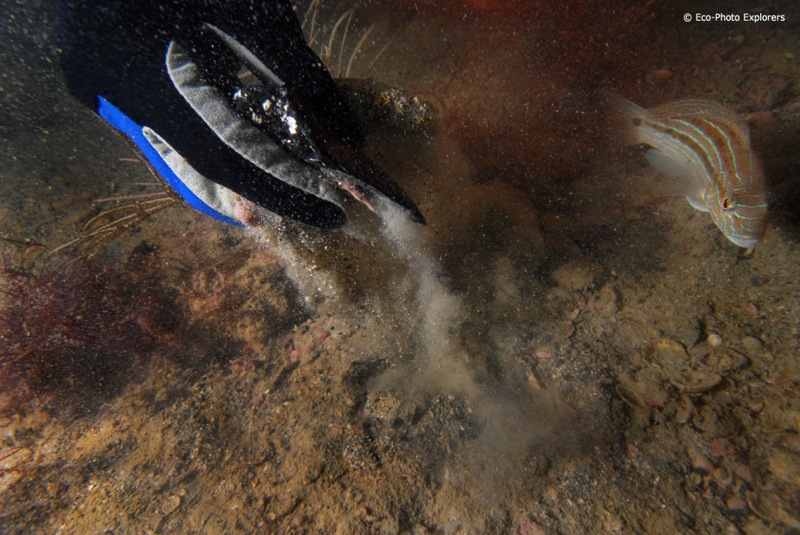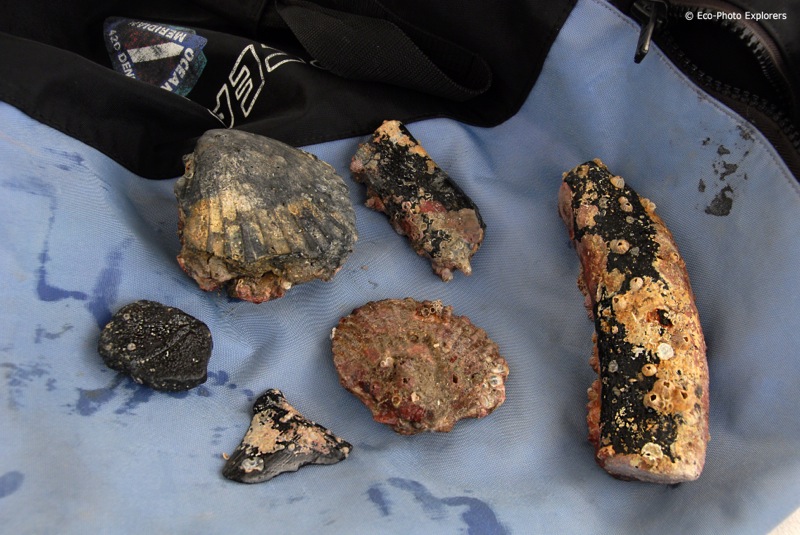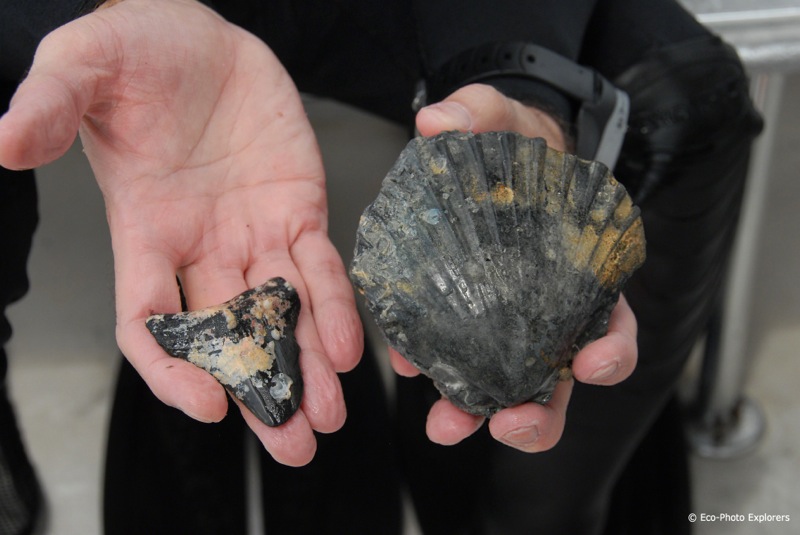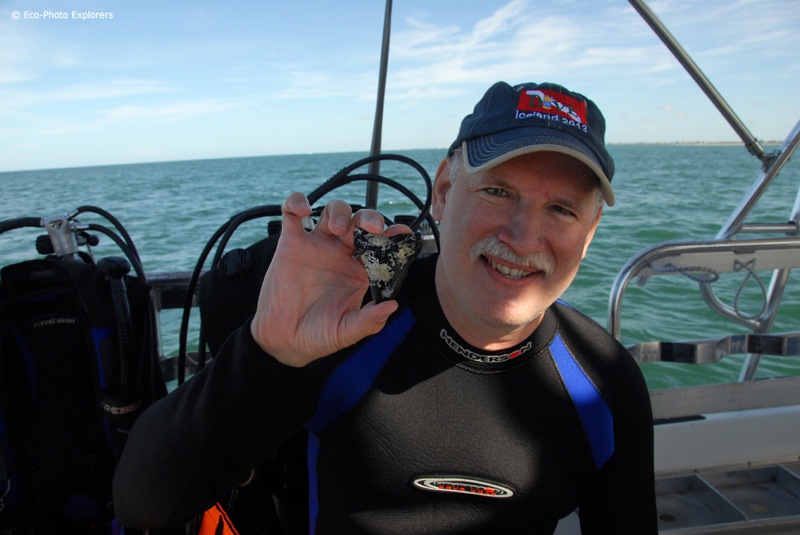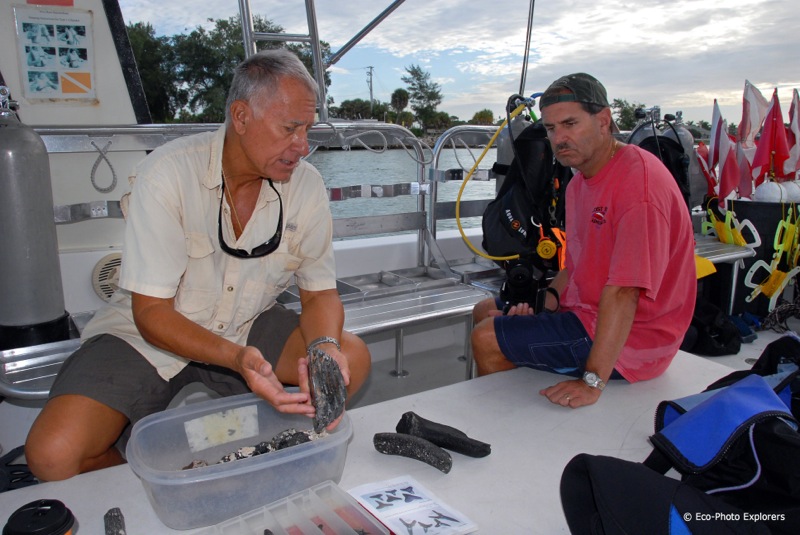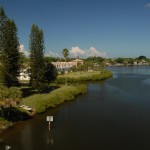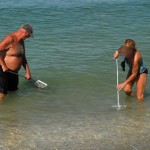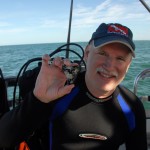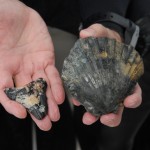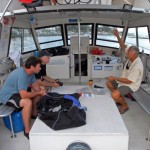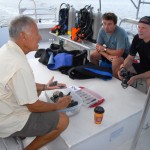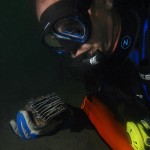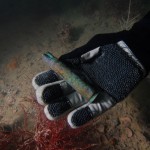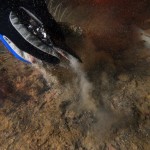The bottom was a mix of pebbles, loose gravel, mud and clay, covered in a fine layer of silt and with only an occasional outcropping of coral and seaweed to break the monotony. Visibility was only a few murky feet at best, but when the silt kicked up it dropped to almost zero. The water was warm, almost too warm, at 88 degrees and we found ourselves frequently opening our wetsuits to let in a brief shot of water to cool us down. Despite these marginal conditions, we were excited to be here, anxious to extend our bottom time and transfixed on the purpose of our dives: we were searching for fossilized shark teeth in the waters off Venice, Florida in the Gulf of Mexico. Specifically, we were looking for Megalodon Shark teeth from 20 million years ago.
”Touch everything, go slow, keep your focus and if you are in doubt, bring it up and let’s have a look.”
Text and Photography by Michael Salvarezza and Christopher Weaver (Eco-Photo Explorers)
Those were the simple instructions from the dive briefing moments earlier. It sounded easy on the surface but now that we were crawling around in 30 feet of water with almost no visibility, the dive was more challenging than we had thought. To our untrained eyes in the dim light of the cloudy water, everything looked like a fossil!
Our hands skimmed over the bottom, pausing with each rock and outcropping to feel if the telltale shape of a tooth could be discerned. At first, other fossils emerged…fascinating in their own way but not the immediate subject of our search. Black colored bones from long-lost Dugongs and fossil teeth from Mammoths, Horses and Whales were the largest and easiest to find. We also uncovered large fossilized 3-inch clams, totally intact with both bottom and top shells. Smaller items, such as the fossilized mouth plates and barb tips of a stingray, were next to emerge from the silt.
As we crept and crawled along the bottom, a pack of opportunistic fish followed on our trail, eager to find tiny morsels of food in the clouds of silt that we were creating along the way. They were finding what they wanted…would we find what we wanted?
Suddenly, a tantalizing find…there in the palm of our hand emerging from a scoop of newly dug up mud, was a tooth. This one, however, was too small to be Megalodon…indeed, it was the fossilized tooth of a Bull Shark.
We kept on digging. And searching. Our eyes tried to peer through the gloom and our fingertips tried to parse the bottom all in search of our elusive quarry.
Lifting a moderate sized rock caused a bloom of silt in the water. We dug our hand into the exposed clay. One scoop…nothing. We dug deeper…still nothing. For some reason, we dug a third time, even deeper. And then, as we lifted the mud and clay into the water, and let the fine particulate drift away…there it was! A 3-inch tooth! This was the fossil we had been searching for: a tooth from the long extinct Megalodon Shark. Research has shown that the size of the teeth of these sharks are roughly a tenth of the size of the shark, so this one came from a shark that measured about 30 feet in length. We were thrilled, exhilarated and eager to continue our search!
Now that we had one, we wanted more…
Finding fossilized shark teeth, or any type of fossil, is not easy. Although the diving conditions were marginal in Venice, Florida, the dives themselves are not challenging. Rather, the difficulty comes in learning how to spot a potential fossil, and to become proficient in the art of patient searching. Shark teeth can be lying right on the bottom, exposed and ready to be found, or they can lie buried inches below the mud, clay and sandy bottom. Because of the limited visibility, it is easy for divers to pass an exposed tooth just a foot or two away. The best techniques involve slow movement, careful examination of the bottom and the persistence to examine every rock and object on the bottom.
Although fossil shark teeth can be found in many locations across all of North America, Florida, and in particular the waters off Venice in the Gulf of Mexico, is an ideal location to find these fossils. The first primitive sharks appeared about 400 million years ago and the first modern sharks emerged about 100 million years ago. What is now known as the Florida peninsula in North America was once a submerged landmass that only began to slowly emerge from the water about 65 million years ago. At first, Florida was just a shallow body of sediments from the sea but it eventually grew into the finger of land that is now jutting out from North America. However, because of fluctuations in the Earth’s climate, Florida was periodically submerged and exposed as the water levels rose and fell with the freezing and thawing of polar ice. By about 2 million years ago, Florida had re-emerged. Presently, Florida consists of a spine of land that runs roughly down the center of the peninsula for about half the state. At its highest, the elevation here is about 300 feet above sea level. The rest of Florida is only a few tens of feet above sea level.
When the spine of Florida rose from the sea, the waters to the south and west (present day Gulf of Mexico) were very shallow. These waters were home to large populations of fish and sharks, including the famed Megalodon Shark. As these marine creatures died, they were quickly covered with sediment. The conditions were perfect for fossilization. So, too, were the land animals, whose remains were quickly washed to the seas by rivers and streams draining from the land to the oceans. Because of the unique geology of Florida, the fossilized remains of these organisms are concentrated in the waters off both coasts of the state. However, since the waters of the Gulf of Mexico tend to stay shallow for great distances, it is easier to search for these fossils on that side of the state. The area south of Tampa towards Venice, because of a unique confluence of rivers and streams, is the epicenter of these fossil beds.
Divers who come to Venice to search for fossils in the waters of the Gulf can choose from several dive operators who provide expert guidance and service in the effort to find fossils and shark teeth. Although divers can explore these waters from the shore, it is a long swim to the productive fossil beds and a boat dive is preferable. Divers will typically enjoy two tank dives of 90 minutes or more bottom time. The dives are shallow and depths rarely exceed 30 feet. To maximize the chances of finding teeth, divers should plan on several days of diving. We dove for two days, making four dives in total, and we discovered two Megalodon teeth, along with a variety of other fossils. Because some of the fossilized teeth and other items can be very small, it is advisable to carry a small fine mesh bag to hold your whatever you find. Many of the dive operators will have these available for purchase if you do not have one.
Shark tooth diving is conducted year round in these waters. In the summer, be prepared for very hot weather, strong sun and very warm water temperatures. In the late summer, divers can use a 3mm or shorty wetsuit as the water temperatures can reach the high 80s. In the winter months, divers will encounter water temperatures in the low to mid 60s. The water is generally calm, and experienced diver operators will help divers contend with any current and will only choose sites most conducive to safe diving and productive searching. When the hunt for fossils is over, the dive operations in the area also charter their boats for visits to offshore reefs and wrecks, with much clearer water and better conditions.
But shark tooth hunting is not just for divers. Non-divers can find small-fossilized teeth right off Venice beach in about waist deep of water. It is best to use a beach-sifting scoop for this type of activity. A sifting scoop generally has a screened cage at one end and has a long shift on the other. Make sure the holes in the screened cage are small enough to trap very small items, but large enough to allow the sand to fall out.
While many species of sharks lived in these waters, the most notable shark to inhabit these waters between 2 and 30 million years ago was the Megalodon Shark. This species reached a maximum size of 60-70 feet in length with a mouth approximately 6 feet wide and 6 feet high. Because the shark’s skeleton is made of cartilage, the only fossil remains of this shark that divers can find are the teeth, which can measure up to 6 to 7 inches in size. Megalodon teeth resemble those of the Great White Shark, but are distinguished by the large dental band that separates the blade of the tooth from the root. Despite recent sensational TV programs claiming to have uncovered evidence of living Megalodons, these sharks are long extinct. Diving for their teeth, and uncovering the fossil remains of these once majestic predators, is the closest we can come to touching these creatures today.
The dive sites inshore near Venice are not beautiful or picturesque. But the thrill of the hunt for fossils is alluring and despite the conditions divers will find that they wish to return again and again to search for the remains of the most magnificent shark to ever roam the seas…Megalodon.
Venice, Florida Dive Operations
Florida West SCUBA & Charters
http://www.megalodoncharters.com
dive@megalodoncharters.com
941-486-1400
Aristakat Charters
http://aristakatcharters.yolasite.com/
aritakat02@yahoo.com
941-321-0852
- The metal structure is beginning to rust.
- The Gasparilla Island Light was once known as the Delaware Breakwater Rear Range Light.
- The Gasparilla Island Light is showing signs of age.
- A boat heads towards the open water of the Gulf of Mexico.
- The waters and canals near Venice, Florida.
- Beachcombers can find fossil teeth in shallow water right off the beach.
- Venice Beach boasts calm waters and sandy beaches.
- Venice Beach is the epicenter of fossil shark tooth finds in western Florida.
- The historic Venice train station.
- The inland waterways around Venice, Florida.
- The 1st dive yields Dugong bones, shell castings, turtle shell fragments and a Megalodon tooth.
- Author Michael Salvarezza listens to the dive briefing.
- The Gasparilla Island Light stands guard over the Gulf of Mexico waters.
- The doorway to the Gasparilla Island Light is in decay.
- The dive boat from Florida West Scuba & Charters.
- The beach at Venice Beach.
- Beachcombers searching for fossilized teeth.
- Author Christopher Weaver holds a Megalodon tooth.
- The intact fossil of a bivalve shell casting and a Megalodon tooth.
- The fossilized remains of a Mammoth.
- Divers listen intently to the dive briefing.
- The dive briefing includes a discussion of fossils.
- Divers listen intently to the dive briefing.
- The dive briefing includes a discussion of fossils.
- A fossilized Megalodon tooth from Venice, Florida.
- A diver examines a fossilized Mammoth tooth.
- These waters once saw military test exercises and divers can still find ammunition artifacts on the seabed.
- Lifting the tooth stirs the silt while a small grunt looks on.
- A diver holds a Megalodon tooth.
- The Gasparilla Island Light keeps watch over the fossilized remains of the famed Megalodon Shark.
- The entrance still bears the date of its re-assembly in Florida: 1927.
Text and Photography by Michael Salvarezza and Christopher Weaver (Eco-Photo Explorers)
All content ©2014 and may not be copied, repurposed, or reproduced in any way without prior express permission.


